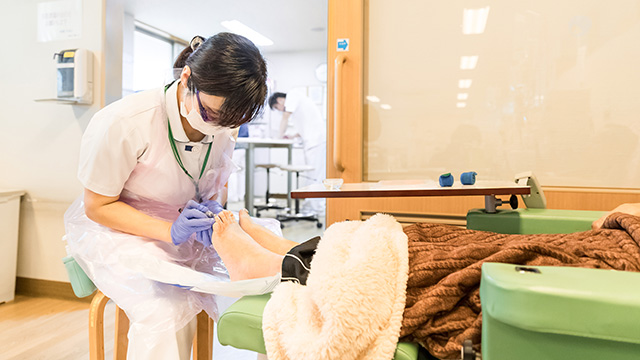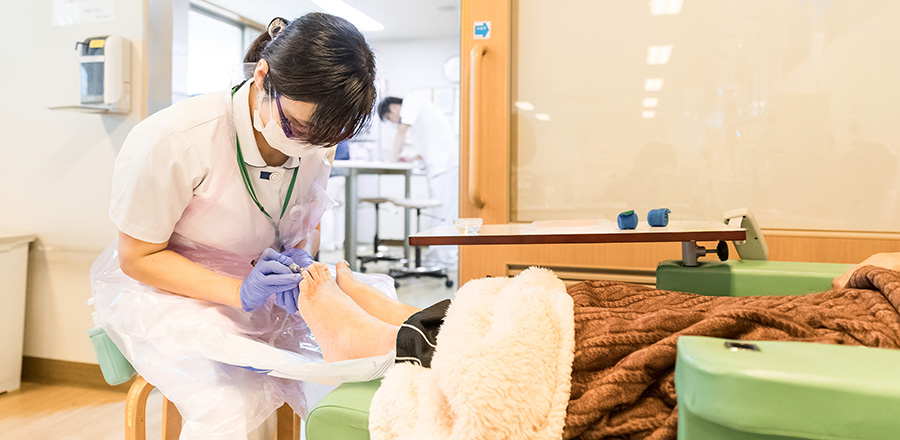

Specialty Outpatient Clinic
In addition to all the treatment departments and general outpatient examinations we also have a specialty outpatient clinic, where, depending on the disease, even more in-depth and specific diagnosis and treatment are performed. In this department, there is not only one performing specialist, but different doctors from related therapy areas teamed-up to develop multifaceted, comprehensive treatment plans.
Renal Insufficiency Outpatient Department
Recently, chronic kidney disease is more often called by its acronym “CKD”.
In Japan the number of CKD and dialysis patients has increased to 13 million and 320 thousand people respectively, of whom 50% requiring dialysis also suffer from diabetes.
As long as diabetes patients are not treated in a medical environment with expertise in renal failure, the number of patients in need for dialysis is unlikely to drop. Baring this in mind, our policy of managing treatment is to closely work together with the diabetes outpatient department.
In Japan the number of CKD and dialysis patients has increased to 13 million and 320 thousand people respectively, of whom 50% requiring dialysis also suffer from diabetes.
As long as diabetes patients are not treated in a medical environment with expertise in renal failure, the number of patients in need for dialysis is unlikely to drop. Baring this in mind, our policy of managing treatment is to closely work together with the diabetes outpatient department.
Vascular Access
Being the core institution for dialysis medicine in the Tokatsu region, in Chiba prefecture, we provide shunts and solutions for dialysis-patients with vascular access difficulties. We also provide percutaneous transluminal angioplasty (PTA).
Given that the age of initial dialysis is increasing, more patients show lower heart function before even starting with the dialysis treatment. In such cases, after detailed interviews with the patient, we conduct subcutaneously fixed superficial artery. Should the forearm of the patient not show a suitable blood vessel for a shunt, we propose arteriovenous graft (AVG) or cuff-type catheters in discussion with the patient and then choose the best suitable vascular access.
Given that the age of initial dialysis is increasing, more patients show lower heart function before even starting with the dialysis treatment. In such cases, after detailed interviews with the patient, we conduct subcutaneously fixed superficial artery. Should the forearm of the patient not show a suitable blood vessel for a shunt, we propose arteriovenous graft (AVG) or cuff-type catheters in discussion with the patient and then choose the best suitable vascular access.
Stoma Care
Our stoma center is the only one in Matsudo-City, which makes its existence very important. (Stoma is a surgically created opening on the abdomen, which allows stool or urine to exit the body)
This department provides specialty care to patients suffering from lower QOL (quality of life) due to poor stoma care or skin problems caused by excretion. Thus, this department will help patient to get back the lifestyle of healthy people.
This department provides specialty care to patients suffering from lower QOL (quality of life) due to poor stoma care or skin problems caused by excretion. Thus, this department will help patient to get back the lifestyle of healthy people.
Endoscopic Examination Center
Along with the main areas stomach and large intestine, we also carry out endoscopic examinations of the esophagus, duodenum, rectum, colon and distal section of ileum. To avoid pain in the case of an oral inspection, we offer sleeping pills. An oral examination normally lasts about 5 to 10 minutes, an anal examination 20 to 30 minutes.
Wound Care Center
We define injuries of skin tissue as “wound”. Due to the shift of our Japanese diet to a more westernized eating culture, the number of patients suffering from arteriosclerosis and diabetes is growing, and thus complications like ulcers and necrosis of feet are increasing, too.
Foot Care Department
When diabetes progresses unchecked, it leads to a reduced blood flow to the feet due to arteriosclerosis. This again results in neurological disorders, such as swelling, shoe sore, aggravated injury and long-term suppuration. In the worst-case, it can end in gangrene and the affected foot has to be amputated.
In the foot care department, we start treatment at the preventive stage of all kinds of foot troubles related to diabetes and chronic renal failure.
In the foot care department, we start treatment at the preventive stage of all kinds of foot troubles related to diabetes and chronic renal failure.
In addition to the specialty outpatient department, a mammary gland and a pain clinic are established here as well.
